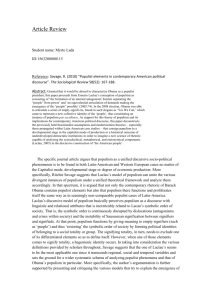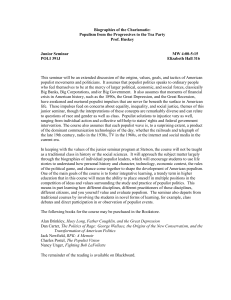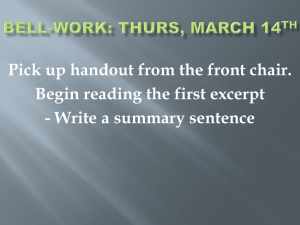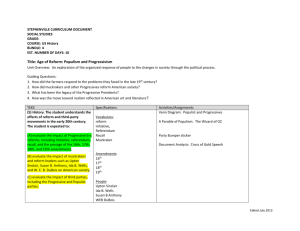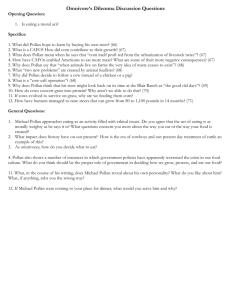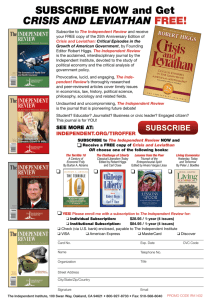NATIONAL AND KAPODISTRIAN
advertisement
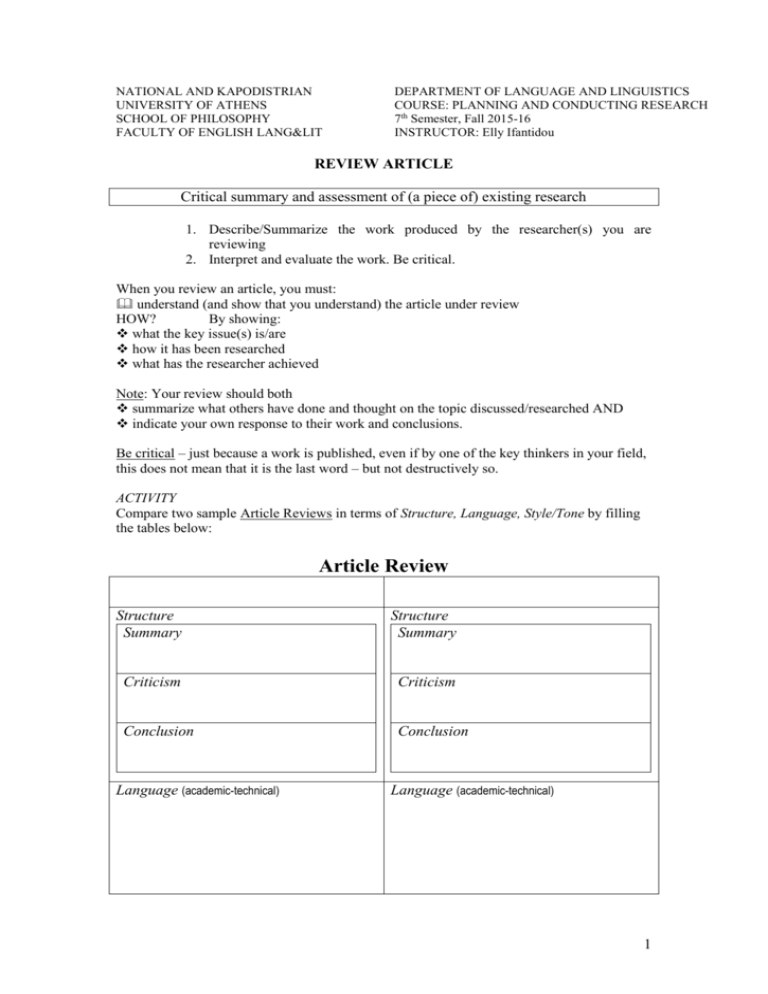
NATIONAL AND KAPODISTRIAN UNIVERSITY OF ATHENS SCHOOL OF PHILOSOPHY FACULTY OF ENGLISH LANG&LIT DEPARTMENT OF LANGUAGE AND LINGUISTICS COURSE: PLANNING AND CONDUCTING RESEARCH 7th Semester, Fall 2015-16 INSTRUCTOR: Elly Ifantidou REVIEW ARTICLE Critical summary and assessment of (a piece of) existing research 1. Describe/Summarize the work produced by the researcher(s) you are reviewing 2. Interpret and evaluate the work. Be critical. When you review an article, you must: understand (and show that you understand) the article under review HOW? By showing: what the key issue(s) is/are how it has been researched what has the researcher achieved Note: Your review should both summarize what others have done and thought on the topic discussed/researched AND indicate your own response to their work and conclusions. Be critical – just because a work is published, even if by one of the key thinkers in your field, this does not mean that it is the last word – but not destructively so. ACTIVITY Compare two sample Article Reviews in terms of Structure, Language, Style/Tone by filling the tables below: Article Review Structure Summary Structure Summary Criticism Criticism Conclusion Conclusion Language (academic-technical) Language (academic-technical) 1 SYNTHESIS OF SOURCES The four academic extracts appear below in random order. Match extracts which refer to the same topic (by two). 1 Over the last decennia, the dominant view has come to be that connectedness of discourse is a characteristic of the mental representation of the discourse rather than of the discourse itself (see Sanders and Pander Maat, 2006, for a recent overview). According to most cognitive scientists, linguists and psycholinguists, understanding discourse means that readers construct a mental representation of the information in the text (Graesser et al. 1997; Gernsbacher and Givon 1995; Garnham and Oakhill, 1992). 2 The academic university registers included in Biber (2006) – classroom teaching, lab sessions, study groups, textbooks, and course packs – all share the primary communicative purpose of conveying information. Even though instructors and textbook authors are also concerned with providing their own perspectives on information, epistemic stance expressions (e.g. in classroom teaching, certainly, I don’t think, data indicate that) are much more common in these registers than attitudinal expressions (e.g. in classroom teaching, I was shocked to find out that). 3 Traditionally, linguists have approached coherence relations and connectives by looking at overt linguistic elements and structures. In their seminal Cohesion in English, Halliday and Hasan (1976) describe text connectedness in terms of explicit clues that make a text a text, such as reference, substitution, ellipsis and conjunction. Cohesion occurs “when the interpretation f some element in the discourse is dependent on that of another” (Halliday and Hasan, 1976:4) 4 A closer consideration of stance features in the spoken academic registers shows that they are often used for functions other than the expression of epistemic or attitudinal meanings. First, stance features are commonly used for directive/obligation functions in academic spoken registers. That is, interspersed with the discussion of informational content, we find classroom instructors commonly telling students what they can do (i.e. what they are able to accomplish), what I want you to do; and what they should, have to, or need to do. Second, stance features are frequently used for discourse organization – for example, prediction modals (I’m now going to talk, we will begin, I’ll make it completely clear) are often used to structure a spoken lecture, identifying the upcoming steps in the presentation (or the course overall). Feedback on: Synthesis of academic sources A synthesis is not a word-to-word paraphrase, but a synthesis of selective information from the original, i.e. significant information only, or information relevant to the main argument developed. As a consequence, a review is considerably shorter in length compared to the reviewed source(s). A synthesis involves your personal evaluation/comment when reviewing the literature for the purposes of conducting your own research. 2 A synthesis should explicitly indicate the relation between synthesized sources – are they contrasting, or complementary, or in a cause-effect relation? Rank by using the criteria (–) word-by-word paraphrase (+) synthesis of selected (significant or relevant) information (+) explicit indication of relation between sources (opposing, complementary) (+) personal interpretation/comment Student answer A Research on spoken academic registers (Biber 2006) indicates by and large that university instructors and textbook writers manifest a relatively strong perchant for the use of epistemic stance features. The latter are usually employed for giving orders (obligation purposes) and for discourse organization as opposed to the infrequent use of attitudinal expressions. In other words, instructors and textbook authors are more likely to use epistemic stance expressions when informing the students about what they can do, what they want them to do or what they should do respectively. Moreover, when stance features are employed for the organization of discourse, they usually come under the form of prediction modals, like “I am now going to/I will, which intend to clarify the sequential steps of the oral presentation of information or perhaps of the whole course structure. Student answer B Research into a series of academic registers has revealed a variety of features related to the stance of speakers. In the case of instructors addressing students in the classroom, epistemic stance was found to be expressed in much greater fluency than attitudinal stance. This finding could perhaps have been expected, given the ‘tenor’ (instructor-student relation, i.e. unequal power) and ‘field’ of the situations observed (instructor providing information and judgements, serving knowledge with different amounts of probability/plausibility attached to it). Beyond that, as shown by closer scrutiny of stance expressions used by instructors when addressing their students in the classroom, stance expressions appear to serve functions other than those on which previous research had focused. In particular, epistemic stance markers were found to fulfil what the researchers termed “directive/obligation” functions, as in I need you to hand in the paper by next Friday, and discourse organizing purposes, such as in I will start the lecture on … Student answer C Stance expressions have been researched in terms of (a) epistemic expressions and (b) attitudinal expressions (Biber 2006). In the suggested framework, it has been claimed that the former are more frequently used compared to the latter. Upon closer observation and analysis, however, additional functions of stance markers have been determined, namely, the ‘directive/obligation’ use, as in I want you to …; you should; have to; need to; and the ‘discourse organization’ use (I’m now going to talk, we will begin, I’ll make it completely clear). 3 Jane Eyre: A Research on How Gender and Religion Issues Are Perceived by the Novel Reader and the Film Viewer Charlton, Michael, Corinna Pette and Christina Burbaum. (2004) “Reading Strategies in Everyday Life: Different Ways of Reading a Novel Which Make a Distinction.” Poetics Today 25 (2): 241-263. The article in hand presents a research on German readers, aiming at illustrating the practices employed when dealing with a piece of literature, namely a novel, and their meanings in terms of coping with everyday life and a person's past. In the first part of the research, six volunteer readers who had spontaneously purchased a specific, recently published novel were interviewed before, during and after they had read the book. The subjects' responses suggested a vast variety of reading practices, which were found to vary depending on the personal characteristics and goals of the readers. The second part of the research consisted of telephone interviews with a representative sample of 1.025 seasoned novel readers, which pointed to a relationship between the reading strategies used and the gender of the readers, as well as their sociocultural background. The survey presented may be considered very important in the field of literary reading, since researchers at large have been mostly avoiding tackling with the specific area of interest. The survey's taking place in two phases was an optimal choice, since there were no data from previous attempts to register reading practices. Another strong point of the research presented in the article is the fact that a variety of methods were used, such as interviews, questionnaires and self-observations, while the number of participants was fairly large. Nonetheless, the criteria used for the selection are not clarified. Furthermore, the classification to milieus is derived by remarks limited to the German society, the differentiation between the genders is subject to the above limitation too. As a result, reservations are held as to whether the findings of the research may be applied in the Greek context or not. In connection with the article's contribution to the research we are planning to conduct, it must be noted that the methodological tools indicated are of great value. There are hardly any studies on literary reading conducted in the form of a research and the present one is deemed groundbreaking. In addition, the notion of differentiation of reading patterns and perceptions in relation to the cultural background is bound to be of help, since in the context of our research, novel-readers and film-viewers will be of diverse backgrounds and comparisons will be made. The theoretical foundation of the research in question, as well as its findings, may help us formulate our hypotheses and evaluate our findings, even though its actual results may not be congruent with ours due to its aforementioned limitations. Violence through Language: How Innocent Are Words of Everyday Speech? Schweinle, William, Ickes, William, Rollings, Kathryn and Jacquot, Colette (2010) “Maritally aggressive men: angry, egocentric, impulsive, and/or biased”. Journal of Language and Social Psychology 29 (4): 399-424. 4 The article is concerned with the relationship between the language used by maritally aggressive men, other characteristics of them (anger, impulsivity, inferential bias and attentional disorder or impairment) and their wife-directed aggression. The authors aspire to shed light on the significance lying in the language employed by such men in predicting their violent behaviour towards their wives. As far as the hypotheses are concerned, these are explicitly stated: the authors expect to indicate that men who describe their marriages by means of linguistic expressions conveying anger are quite maritally aggressive and so are thought to be highly impulsive men. They also attempt to show that attentional disorder/impairment results in increased wife-directed aggression and, finally, that the same holds true as regards the strength of the men’s critical/rejecting-overattribution bias. The study relies on findings of previous research, which actually pointed to the aforementioned characteristics as crucial indicators of maritally men’s aggression. Rather than simply confirming, the article further examines the specific issue and concludes with additional factors that play a significant part in predicting these men’s violent behaviour. In the end, it comes up with two types of maritally aggressive men, but suggests further research into the specific characteristics of each type. The cornerstone of the study involved is the assumption that language is the medium through which people express aspects of their personality and emotional life, even unintentionally. Besides, the importance of linguistic word count analyses has been supported by previous researchers (Cohn, Mehl, Pennebaker, Forgas and Tehani) to whom explicit reference is made. The article is of particular interest to my research topic, which concerns the way that violence is reflected on everyday speech; it can actually provide valuable assistance as regards its investigation through examining the language used by ordinary people who are yet to be labelled as violent, abusive or otherwise aggressive. Moreover, it generated certain ideas as regards the questionnaire of my research. For example, I could employ pictures presenting scenes of mild or more intense violence and then ask participants to write down what comes to mind while looking at them. Although the article examines only men’s aggressive behaviour, it may come as a surprise that certain findings could apply to women as well, since participants of my research are expected to be mainly female. The material presented by the authors includes: findings stemming from the Linguistic Inquiry Word Count software, self-report items, responses to items on the Revised Dyadic Adjustment, the Conflict Tactics Scale, a measure of socially desirable response bias, one of four temperament facets as well as a version of the empathic accuracy paradigm. It is particularly helpful that detailed explanation of the material and tables enabling a visual and statistical representation of the findings are provided, which in turn facilitates the comprehension of the scientific procedure. Nevertheless, technical symbols such as M, SD, r, p and terminology like z-scores and standardized coefficients are not explained; thus, a reader lacking relevant knowledge understands their meaning solely by inferring from context. In addition, all the participants involved come from Texas and are married, which admittedly raises questions about whether the sample is representative enough. What is more, only married men are examined. Nonetheless, aggressive behaviour may precede marriage, meaning that analysing the behaviour of men in romantic relationships on the whole could point to additional factors predicting and leading to marital aggression. The authors explain that they focus on men because previous research has indicated that violence on their part is the most prominent issue and suggest further investigation into women’s violent behaviour. In fact, my research could potentially show that similar findings apply to women as well, as a widely-held assumption is that the 5 “weaker” sex has become more aggressive and masculine nowadays in both personal and professional life. All, in all, this study is ground-breaking in that it suggests that first-person singular and first-person plural references are not correlated with wife-directed aggression. Instead, the use of third-personal singular pronouns interestingly enough points to Machiavellianism, meaning that employing pronouns such as “we”, “us” and “our” – which are seemingly collectivistic – can actually imply a manipulative behaviour. The article, finally, can prove useful in recognising signs of aggression – even when it comes to our own behaviour – which we ought to take care of in light of stable and more “peaceful” social relations. Μetaphor as a means of polarizing the audience and constructing a collective identity in Obama’s political discourse Savage, R. (2010) “Populist elements in contemporary American political discourse”. The Sociological Review 58(52): 167-188. The specific journal article argues that populism as a unified discursive sociopolitical phenomenon is to be found in both Latin-American and Western European cases no matter of the Capitalist mode, developmental stage or degree of economic production. More specifically, Ritchie Savage suggests that Laclau’s model of populism can unite the various divergent instances of populism under a unified theoretical framework and analyze them accordingly. In that spectrum, it is argued that not only the contemporary rhetoric of Barack Obama contains populist elements but also that populism there functions and proliferates itself the same way as in seemingly non-comparable populist cases of Latin-America. Laclau’s discursive model of populism basically perceives populism as a discourse with linguistic and relational attributes that is inextricably related to Lacan’s symbolic order of society. That is, the symbolic order is continuously disrupted by dislocations (antagonisms and crises within society) and the instability of Saussurean signification between signifiers and signifieds. At that point, populism functions by giving meaning to empty signifiers (such as ‘people’) and thus ‘restoring’ the symbolic order of society by forming political identities of belonging to a social totality or group. The signifying totality, in turn, needs to exclude one of its differentiated elements so as to define itself. However, when one of those elements comes to signify totality, a hegemonic identity occurs. In taking into consideration the various definitions provided by scholars throughout, Savage suggests that the one of Laclau’s seems to be the most applicable one since it transcends regional, social and temporal variables and sets the ground for a wider systematic schema of analyzing populist phenomena and that of Obama’s populism in particular. More specifically, the author’s argumentation is further supported by presenting and critiquing the various models that try to explain the emergence of populism in both Latin-America and Unites states as failing attempts to grasp the phenomenon of populism in its totality. Moreover, according to the writer, the affiliations shared between Western European ‘New Populism’ and Latin –America populism in promoting the same anti-system, centralized and authoritarian structures, further suggest the above mentioned argument that populism cannot be fully explained within economic and historical frameworks alone. Finally, Obama’s election is illustrated as an instance of populism following Laclau’s model of analysis accordingly. In Obama’s case, it is claimed that the symbolic order of 6 society was disrupted by the economic crisis along with people’s disenchantment with the up to then Republican administration. This new state of affairs had left behind unanswered popular demands that were linked to Laclau’s “equivalential chain of demands” and finally filled in the system of abstract signification by providing with meaning and identity the signifier of the ‘American people’. This article is particularly enlightening in raising awareness of how populism has been perceived so far across cases. We as readers trace throughout it the thesis that it is insufficient to analyze populism only in terms of historical reasons and developmental modes of capitalism alone; One should instead apply Laclau’s model of analysis so as to draw parallels between strikingly divergent instances of populism and understand its structural pattern. This suggestion is convincingly supported by two theoretical assumptions. The first assumption in support of this thesis is that despite the various populist instances, populism has always the same discursive structure applied to all instances as well as that Laclau’s unifying model can indeed always provide the larger theoretical framework. The second assumption which is expressed is that the literature review of the various models of analysis in the United States, Latin-America and Western Europe reveals itself the failure of a unified conception of populism. In justifying these assumptions Savage extensively discusses Laclau’s model and provides us with a historical overview of the various analyses. Savage uses her material with awareness and cautiousness. She follows a logical order in presenting them that bridges the gaps among the various theories and builds up a solid argumentative sequence. She is also critical on omissions and reliability of each theory. However, some Lacanian terms used in the article miss a proper definition. In terms of validity though, one could argue that the specific article is not too strong. Savage provides us with an extensive literary analysis of her topic accompanied by historical accounts on populism which altogether are thoroughly discussed. However, their interpretation is based mostly on theoretical grounds and on the author’s personal observation. That is to say with the exception of the empirical evidence provided by other scholars, the specific article lacks a solid methodology used of its own. As far as our own research project is concerned, the specific article’s contribution to our topic is of high importance. First of all, it extensively discusses the phenomenon of populism’s emergence in America which is of direct relevance to the formation of the collective identity in political discourses studied by our research project. Moreover, it offers indispensable insight on how populism systematically manipulates the sense of totality by filling abstract significations with meaning and it explains, thus, how populism disseminates itself across cultures. In addition, this journal article is directly associated to our study by presenting Obama’s campaign slogans such as ‘Yes we can’, ‘Hope’, ‘We Are the People We’ve Been Waiting For’ as genuine instances of populism. Finally, the discussed article, as a whole, is judged to be thorough, clear and convincing enough in discussing populism through multiple perspectives. However, there is yet one perspective which has been left undiscussed and needs to be taken into account; the psychological one. In assuming that populism is characterized by a structuralist pattern that is applicable to all cases its psychological dimension is neglected. In other words, what is argued here for further discussion is that people cannot be perceived as passive receivers of populist significations. More or less they encompass different views, attitudes and thoughts that vary their response even to the same instance of populism or ideology and thus affect the whole approach to populism as such. 7 THE ARTICLE CRITIQUE: ΕVALUATION CRITERIA 1. Length of reviewed journal article must be 15-25 pages. 2. Balance between summary-criticism: Criticism outweighs (or equals) description/summary of article. 3. Criticism in the review includes a detailed, in-depth analysis of: A. significance of study in the given research domain B. hypotheses, methodology, findings. These are discussed not in generic terms (e.g. the methodology is valid; the findings are convincing; the study is useful for designing our questionnaire) but illustrated and justified with reference to the reviewed study, and with reference to specific aspects of your research (e.g. The study instigated the design of several of the test questions we intend to include, for example, by including pictures of mild or more intense violence and asking participants to write down what they think.) C. the content of the journal article, i.e. quality, sophistication, significance of, repercussions of the study. How has the specific study been taken up by later research? Do not comment on the presence of introduction, academic language/style, tables, which are ‘given’ features of academic research. 4. Relevance to your study: in what specific ways the reviewed journal article is expected to contribute to your research: has it expanded your theoretical background? Has it instigated your methodology? Has it provided further evidence for your findings? Has it contradicted your findings? Has it raised intriguing questions? Avoid generalizations or platitudes. 5. English language proficiency: word order, vocabulary and academic style add to the flow of ideas, rather than impeding it by convoluted writing. 8 REVIEW OF THE LITERATURE What is a ‘review of literature’? A review is a required part of research papers and often a chapter in theses and dissertations. Generally, the purpose of a review is to analyze critically a segment of a published body of knowledge through rough summary, classification, and comparison of prior research studies, reviews of literature, and theoretical articles. A review may be a self-contained unit -- an end in itself -- or a preface to and rationale for engaging in primary research. Why review? Benefits to the researcher-reviewer: In the mini-research project assigned for the purposes of this course, you will have to review the existing research (in the form of books, journals etc.) on your chosen topic. There are a number of reasons and benefits for doing so. You gain access to invaluable bibliographies in your research area. Access to these bibliographies is sufficient justification, in itself, to get actively engaged in researching the chosen topic. You need a starting point, and reviewing the literature is certainly a good place to begin: e.g. to search for a topic (if you do not already have one), to update your knowledge on your topic, and especially, if you are aiming at a promising and inspiring thesis, to adapt your topic to what is currently at the forefront of academic discussions and/or open to investigation. You familiarize yourself with previous important achievements relating to your topic as well as gaps or flaws in work already conducted. This will help you (re)formulate your own research interests and topic. You sharpen up your judgement as an academic thinker and researcher, because reviewing the literature gives you an insight into how heavily research relies on originality, creativity, follow-up work and counter-argumentation. Writing the introduction Define or identify the general topic, issue, or area of concern, thus providing an appropriate context for reviewing the literature. Define key terms. Point out overall trends in what has been published about the topic; or conflicts in theory, methodology, evidence, and conclusions; or gaps in research and scholarship; or a single problem or new perspective of immediate interest. 9 Establish your reason (point of view) for reviewing the literature; explain the criteria to be used in analyzing and comparing literature and the organization of the review (sequence); and, when necessary, state why certain literature is or is not included (scope). The criteria (see above) may refer to tracing the historical development of the research, assessing the methodologies used in prior research, comparing the findings of existing studies, assessing theories used to account for the phenomenon under investigation. Writing the body Group research studies and other types of literature (reviews, theoretical articles, case studies, etc.) according to common denominators such as qualitative versus quantitative approaches, conclusions of authors, specific purpose or objective, chronology, etc. Summarize individual studies or articles with as much or as little detail as each merits according to its comparative importance in the literature, remembering that space (length) denotes significance. Provide the reader with "umbrella" sentences at beginnings of paragraphs, "signposts" throughout, and brief "so what" summary sentences at intermediate points in the review to aid in understanding comparisons and analyses. Writing the conclusion Summarize major contributions of most significant studies and articles on your topic, maintaining the focus established in the introduction. Evaluate the current "state of the art" for the body of knowledge reviewed, pointing out major methodological flaws or gaps in research, inconsistencies in theory and findings, and areas or issues pertinent to future study. Conclude by commenting on the relationship between the central topic of the literature review and your topic. How does your topic fit in, or emerged out of the body of literature reviewed? GUIDELINES FOR THE ARTICLE REVIEW The first and most important step in writing a review of a critical article is reading it carefully a number of times until you come to a full understanding of the author's position. Your first reading will give you a preliminary impression of the author's thesis and will help you understand the basic structure of argument. When reading the article a second time, it may be helpful to consider some of the following questions and jot down notes to clarify the author's position: What is the author's primary thesis? What is the aim of the article? 10 What arguments or examples does the author use to support his/her position? Are these arguments/examples adequate to defend his/her thesis? Once you understand the author's position and the arguments he/she uses to support it, decide whether or not you think his/her position is convincing. If so, explain how and why the author's arguments successfully lead to his conclusion; if you can think of any further points in support of the thesis, present them and explain why they are significant. If you disagree with the author, determine why you feel his/her arguments are inadequate. Are the examples he/she uses not concrete enough? Is he/she misinterpreting the data? Are there factors which the author has failed to take into consideration in his/her analysis? Steps to follow in writing your article review: Start out with your own summary of the article. Provide your general, overall reaction and specific comments. List the article’s strengths. Be kind. Be frank, in a tactful way, about your own emotional reaction. Make sure you do not produce a hostile or ignorant review. Expend extra efforts to give the article a careful, constructive review. Be affirmingly critical, drawing attention to any major significant points and to the article’s contribution to your topic. 11

